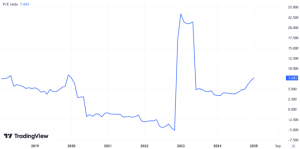As with other major oil producers, demand for FTSE-listed Shell (LSE:SHEL) shares have taken off at the start of 2025. Up 6.1% since 1 January, the business has been driven higher by an mid-single-digit rise in Brent crude prices.
In the last seven days, Shell’s been the fourth-most-purchased share, trust or fund among investors using Hargreaves Lansdown‘s platform. One reason is the potential boost that resurgent oil prices could give to the company’s dividends.
Dividends here have more or less doubled since the depths of the Covid-19 pandemic. And City analysts expect this proud record to continue, as can be seen in the table below:
| Year | Dividend per share | Dividend growth | Dividend yield |
|---|---|---|---|
| 2024 | 139.30 US cents | 8% | 4.4% |
| 2025 | 146.60 US cents | 5% | 4.7% |
| 2026 | 154.20 US cents | 5% | 4.9% |
You’ll also notice that dividend yields for this year and next sail above the FTSE 100 average of 3.6%.
It’s important to remember
though, that dividends are never, ever guaranteed, and that Shell faces threats that may put these forecasts in jeopardy. So how robust do these payout estimates look? And should investors consider buying the oil major for passive income?
Strong numbers
The first thing to consider is how well these expected dividends are covered by anticipated earnings. As an investor, I’ll be looking for a reading of 2 times and above. At these levels, businesses typically have enough room to pay dividends while continuing to invest in their operations.
On this metric Shell scores incredibly highly. For both 2025 and 2026, dividend cover is 2.6 times.
The next thing to look at is the strength of the company’s balance sheet. This is especially important for oil explorers and producers, whose operations require large amounts of capital expenditure.
Shell’s made strong cash generation one of its prioritises, and it continues to make good progress on this front. Free cash flow was $10.8bn in the third quarter, a result that helped pull net debt more than $5bn lower year on year to $35.2bn.
Net debt to adjusted EBITDA consequently fell to 2.2 times, which is reasonable, in my opinion.
However…
Based on all the above, Shell looks in good shape to meet those sunny dividend forecasts. Yet I still have reservations about the oil major’s ability to provide a large and sustained passive income.
Fossil fuel producers are highly cyclical, and a sharp fall in oil prices can cause dividends to fall short despite solid numbers like those above. This is what happened in 2020, when Shell sliced the dividend for the first time since 1945.
While oil prices are rising today, significant supply-and-demand-side threats persist at the start of 2025 that could see them weaken significantly again, hammering Shell’s profits and cash flows. These include soaring output from the US, Canada and Brazil, and poor Chinese demand as the Asia’s largest economy splutters.
As someone who invests for the long term, I’m also concerned about Shell’s ability to consistently pay market-beating dividends as cleaner energy sources become increasingly popular. The firm’s decision to slash renewables-related spending (including to below 10% in 2024) could leave future profits and earnings even more vulnerable in this landscape.
Despite its high yields, I think passive income-chasers should consider passing on Shell shares today.
This post was originally published on Motley Fool







